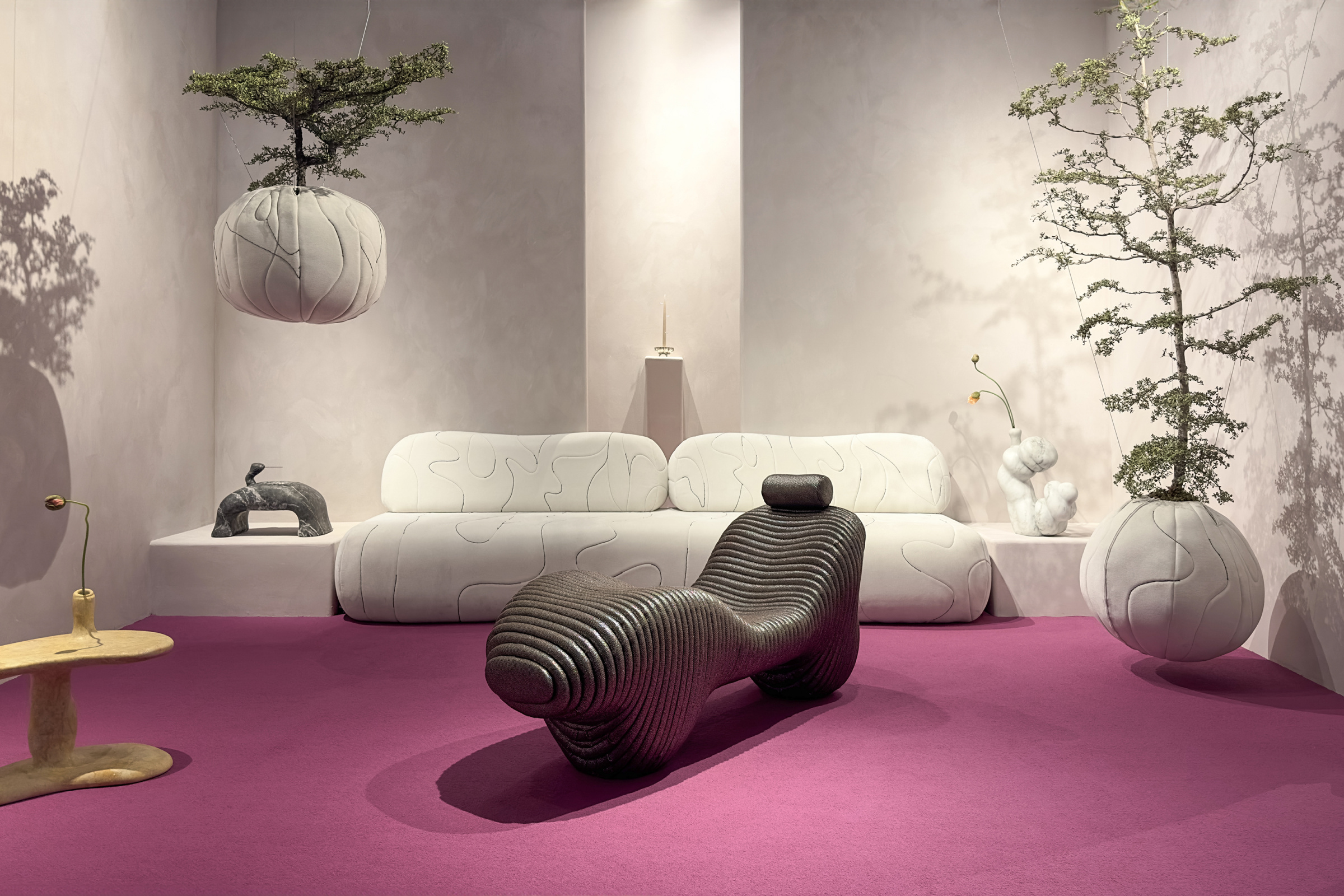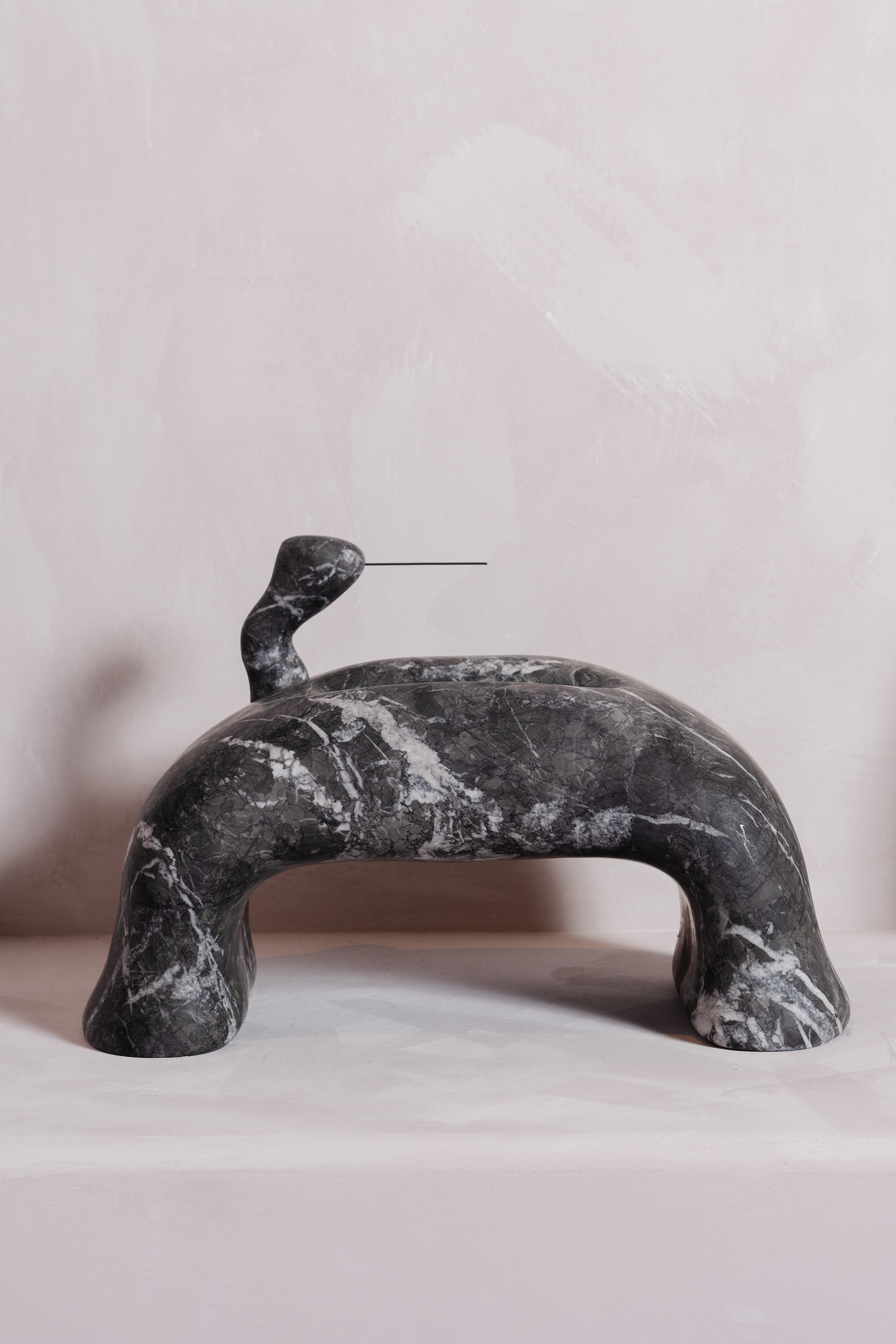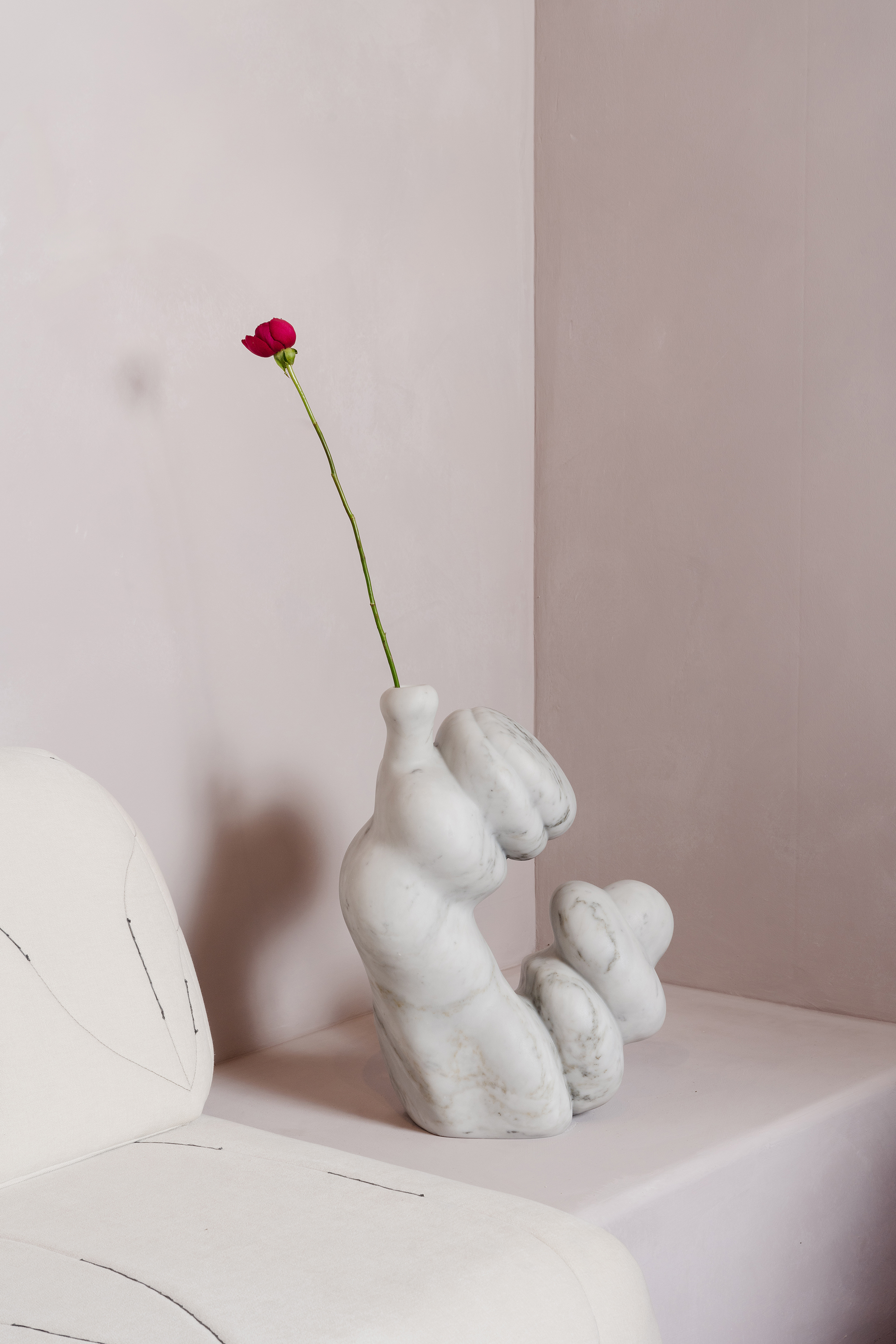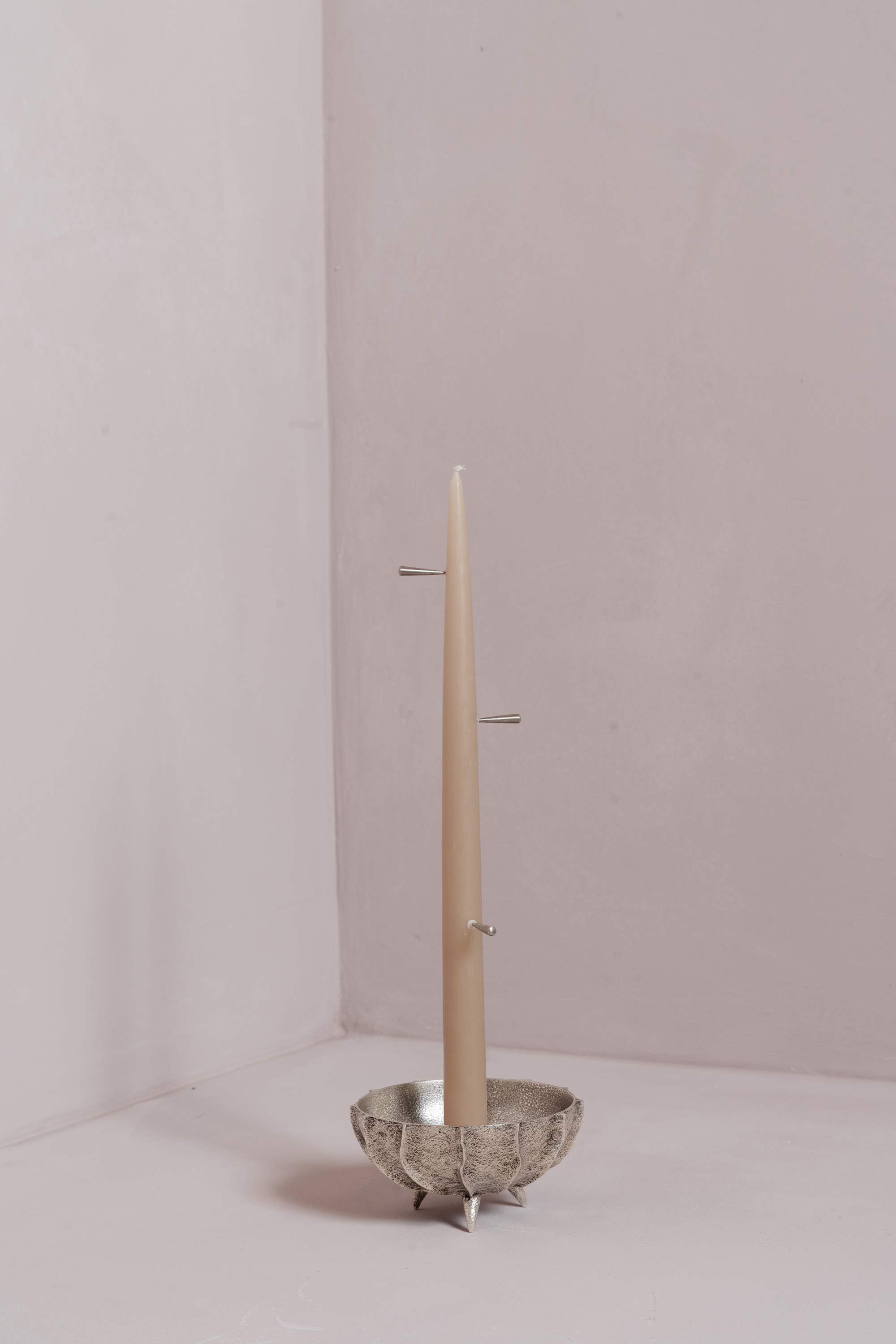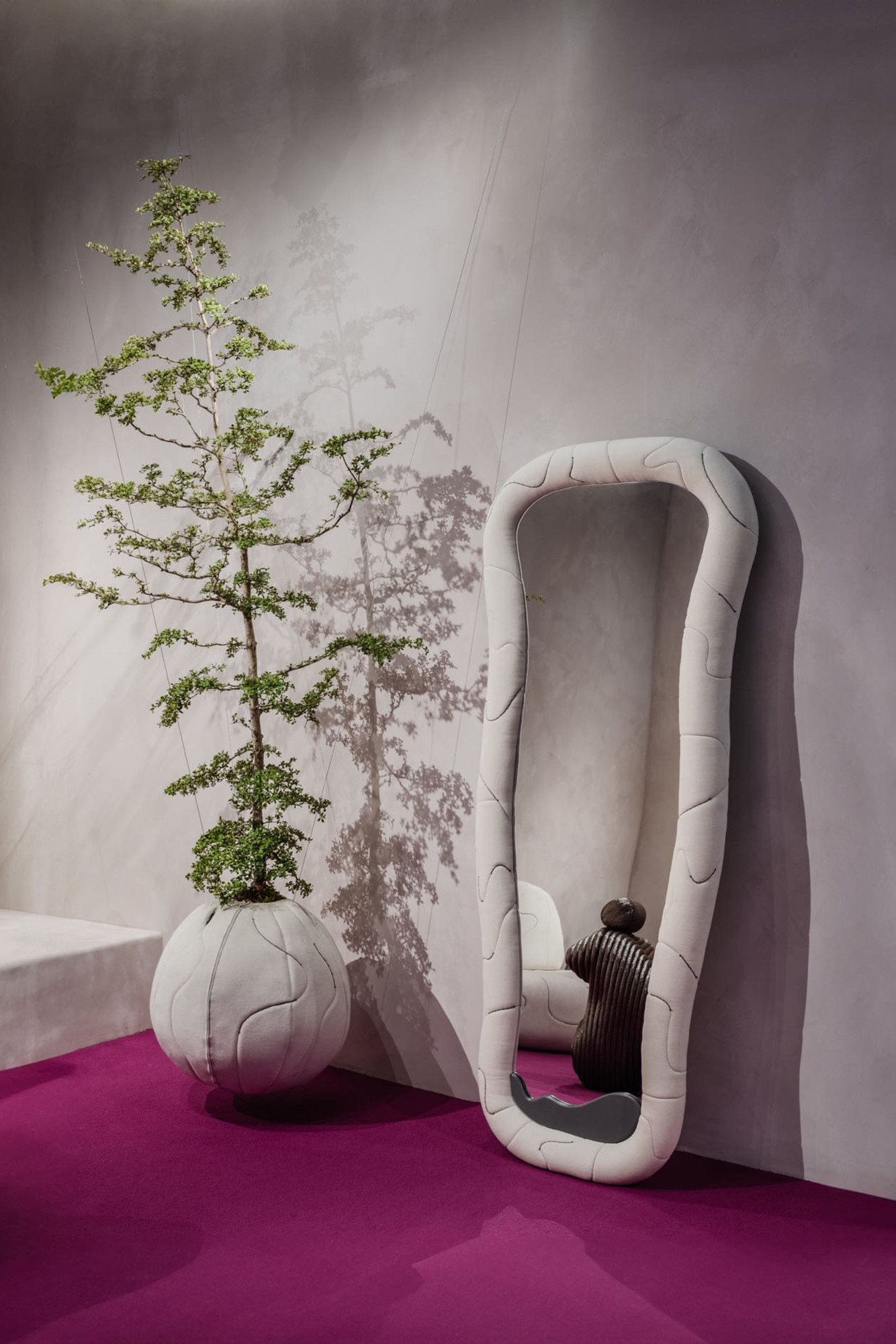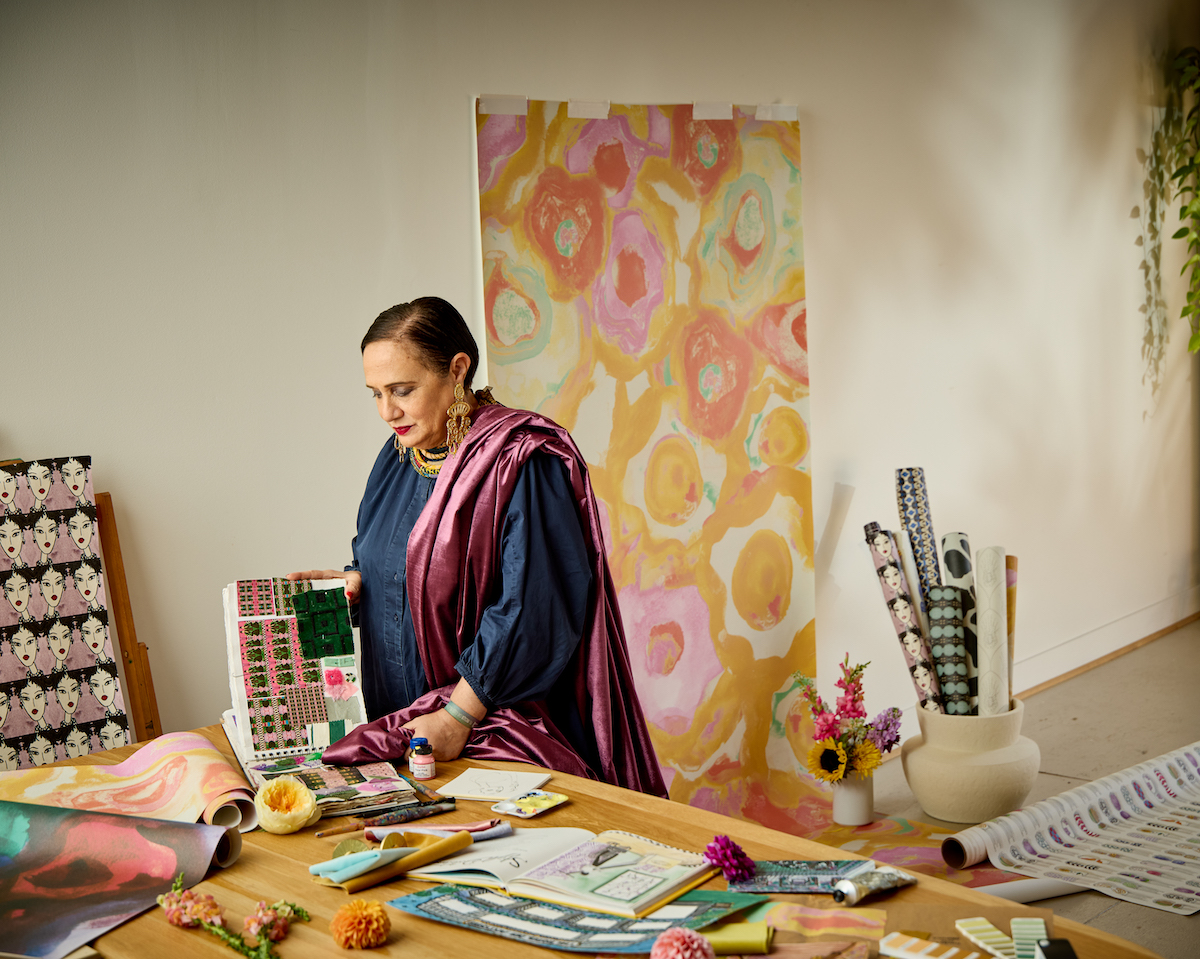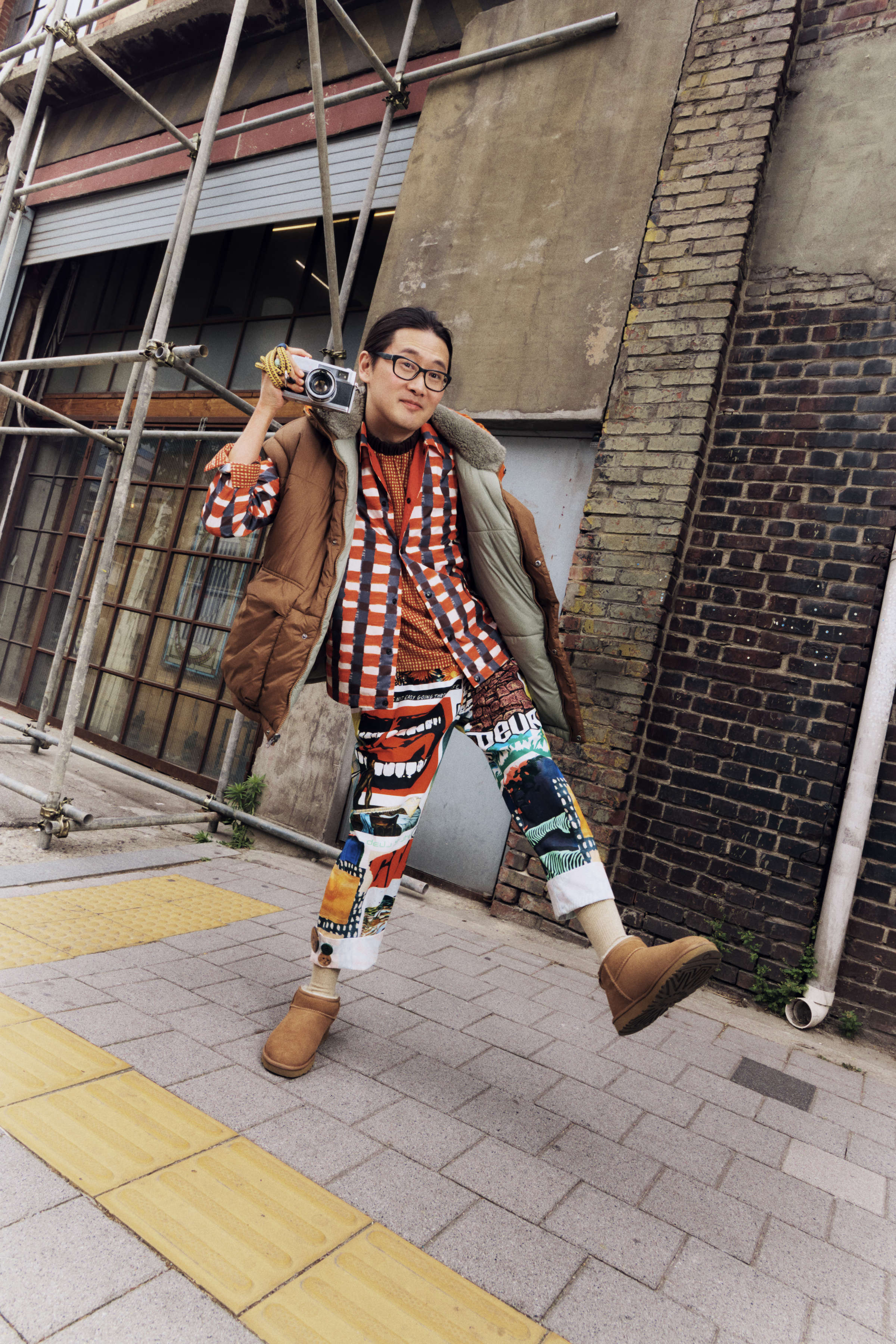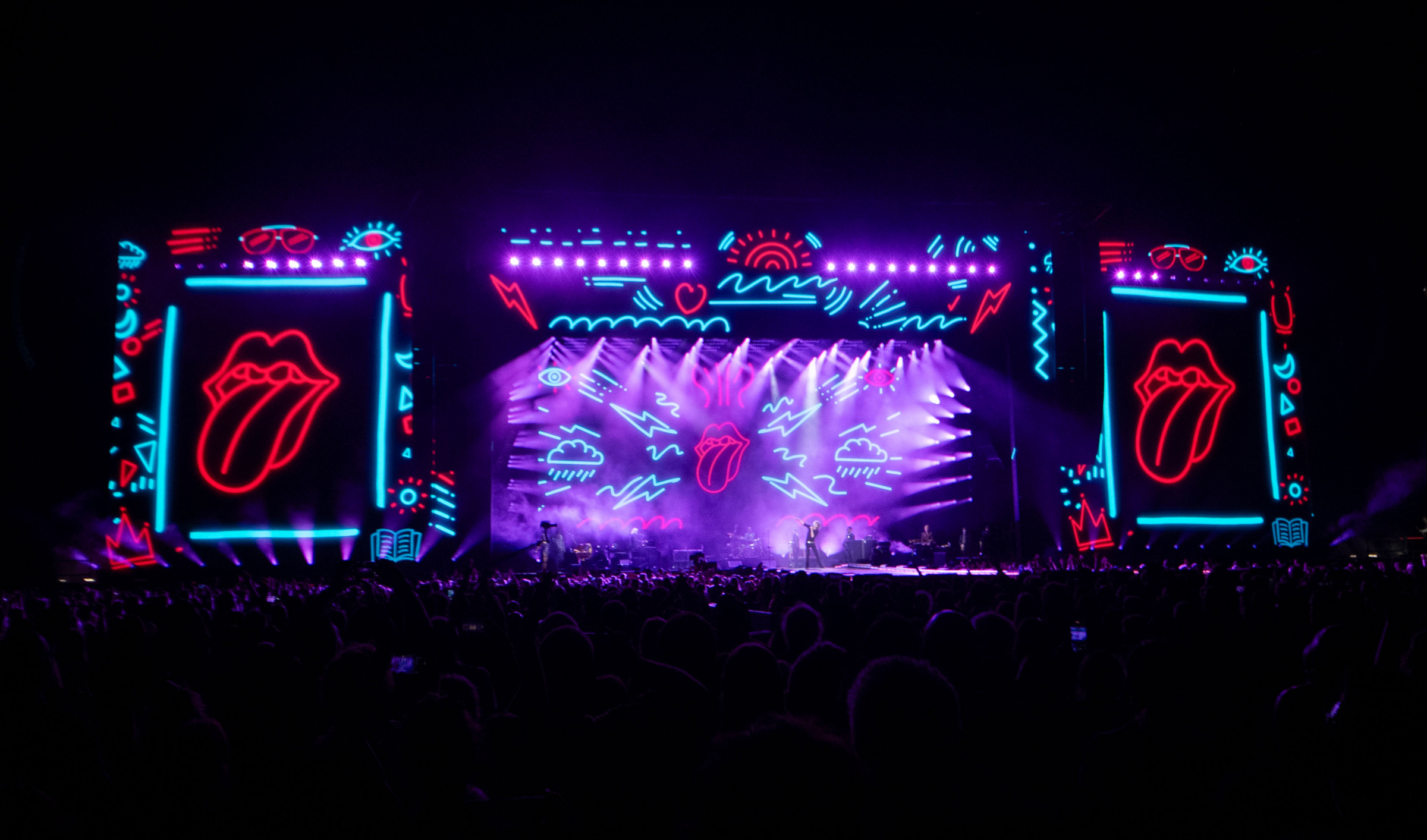According to Moral Turgeman, in the future, design will indulge all five senses. Through her studio Raise the Moral, the Los Angeles-based multidisciplinary designer creates immersive, haptic experiences through objects, architecture, and furniture. In addition to the usual tactile sensations — outfitting her designs with soft, cotton upholstery or delicate, embroidered stitching — her creations allow people to feel sound traveling through their bodies.
At Design Miami 2023, Moral and her creative partner Kelsey Falter won the Curio “Best in Show” award with their pop-up exhibition BECOMING FAMILIAR. There, they featured three collaborations that rumbled with transductive sound, a sonic experience that is felt through the body instead of heard through the ears. Working with composer Joel Shearer, the parametric “Caterpillar,” cloudlike “Landing Pad,” and pillowy “Wing” all discreetly hid the technology that delivered this physical, meditative music.
Moral sees tech as a necessary component for building sensory furniture, yet she also utilizes traditional art and design to cultivate multi-functionary pieces. Her sterling silver candle chime, “Apex,” rings when a pin drops from melting wax and plunks into a deep, scalloped bowl. As the pins slowly plink into the vessel, the listener can mentally, reset at every interval, and ruminate on the passage of time.
Moral is gearing up for another group show that will coincide with Frieze Los Angeles from February 29 – March 3. Before heading into the Barker Hangar to schmooze with art dealers, stop by Maison Luna to see a new chair by Raise the Moral in the group show A Time Was Had: Is An Awakening, which runs from February 24 through March 8.
In advance of the show, Sixtysix sat down with Moral to learn more about designing for the senses and her collaborative process.
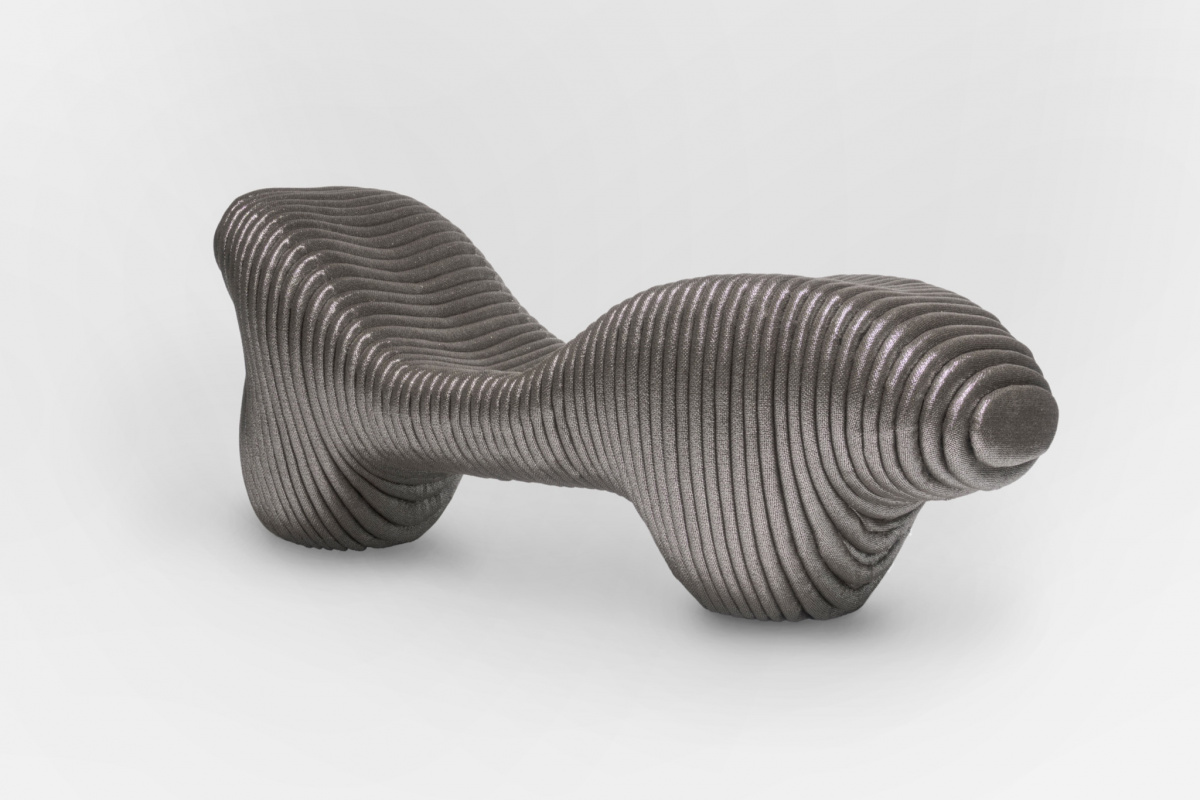
The Caterpillar chair, a parametric lounger, uses transductive sound to create a tactile experience.
Hi! Thanks for chatting with me today. Can you tell us a little more about Raise the Moral?
Moral Turgeman (MT): I’m the founder of Raise the Morale studio. We’re based in Los Angeles, but we have headquarters in New York and produce in Portugal as well. I started doing installation art with hotels that were more like semi-permanent works and then moved into private commissions. Then, during the pandemic, I settled roots back in Los Angeles, where I started working in the studio with smaller objects.
I’ve recently been working on furniture, which is what you saw at Design Miami. This work circles back to my work as a creator way before Raise the Morale even existed. In my twenties, I worked for a director/cinematographer, and in commercial advertising and music video production. That shaped what I was able to do with Raise the Moral because I worked in fast-paced, large-scale production environments. I learned the back end of being able to execute large-scale visions.
I’ve been working on growing the studio because, ultimately, I want to collaborate with artisans, designers, craftsmen—you know, people in all fields, to execute excellence. Our team has a mathematician, an architect, and graphic designers. People who are hands-on.
Could you tell us more about your collaboration with the designer Kelsy Falter, and your booth for Design Miami?
Kelsey and I have worked on other projects before, so her involvement in the process is interwoven into the creative process. We have a massive mountain of trust with each other.
In terms of a collaborator, Caterpillar had already existed, but all the other pieces that were in the booth were an extension of a collection. We’d been working on haptic objects with Joel Shearer, who made the music for Caterpillar, which was incredible. So the three of us worked on that together, but then Kelsey and I worked on the other hardware and designs together and brought the experience to life. Her sister ran the booth. It’s just one big family of creators that gets to come together for these various happenings.
We’re working on a new design that’s a more entry-level piece. It’ll be more affordable than these other pieces that were shown at Design Miami. It will be a little bit more consumer-friendly, but still an art object.
Our relationship goes beyond just Design Miami. There are a lot of people that are behind the scenes that don’t get mentioned as well. We all live in different places. Some of them live in LA, some of them live in other locations, and we work together across different time zones. It’s really fun. Everyone has something different that they bring to the table.
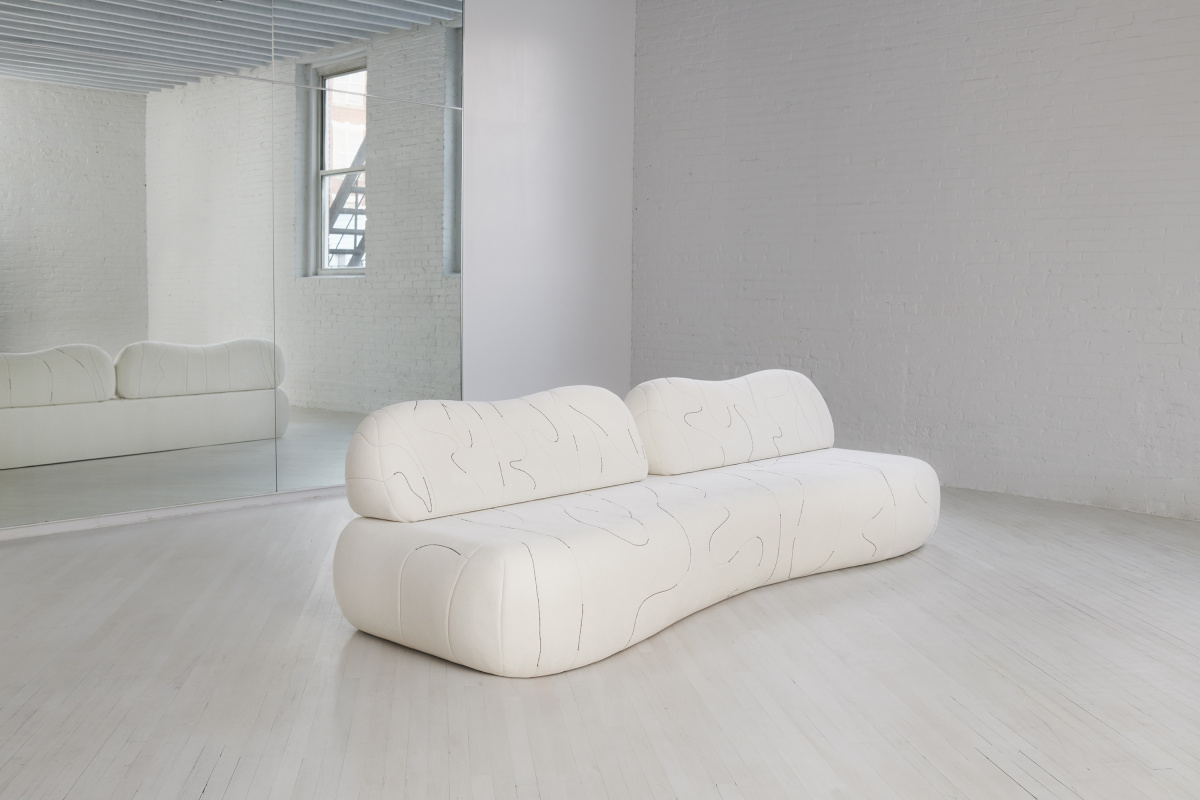
The Wing backrest and Landing Pad ottoman are modular pieces that can be freestanding or placed in various configurations.
What is Kelsey’s skill set? What is yours?
She is a designer as well, but she also has a tech and business background. I would say that the collaboration is more of a partnership than a collaboration in a lot of respects. At the same time, it’s not just her and I that can bring every element of our vision together. It takes the other counterparts, so I think that that’s where the magic happens.
She has autonomy in the design space when it comes to the projects that we work on together because of the level of trust that we have with each other. In terms of the story behind BECOMING FAMILIAR, the brand itself, she’s a big part of that—the writing, the elements, so that’s why I said it’s more of a partnership. BECOMING FAMILIAR is something that we will continue, and pieces are going to be released this year. We’re calling it lifestyle design. These are pieces that you can live with and interact with. They are about ritual, they are about adornment. The haptic pieces you can sit on and use like a healing space, but they’re also pieces that you can just use to watch entertainment. I’m not really a TV person myself, but you could hook this up to your TV and have an immersive sound experience while you’re watching a film or your favorite TV show.
So the haptics are sound pieces?
Yes. So there’s Caterpillar, Landing Pad, and Wing. For Caterpillar, inside of that is a 40-hour battery. So there’s no cables coming out of there. That can be charged by solar panel and comes with a small solar panel, or you can plug it in. It has speakers inside, but they’re not regular speakers. They’re called transducers and they vibrate, sound. So it’s a tactile sound experience. It’s the sound that you feel versus hear. Joel Shearer made the music compositions that played through these devices at Design Miami.
We’ve released three designs, but the collection is going to be nine pieces.
Will they have the same form, or will they be new variations?
There’s variation. They’re all designed for different spaces and they have different moods. But everything is still customizable. For instance, the pieces you saw at Design Miami, the couch has hand embroidery that shows oscillating patterns. It doesn’t have to be there. It can be whatever color for your home. To date, everything has been commissioned work, but we will soon release something that’ll be more consumer-ready.
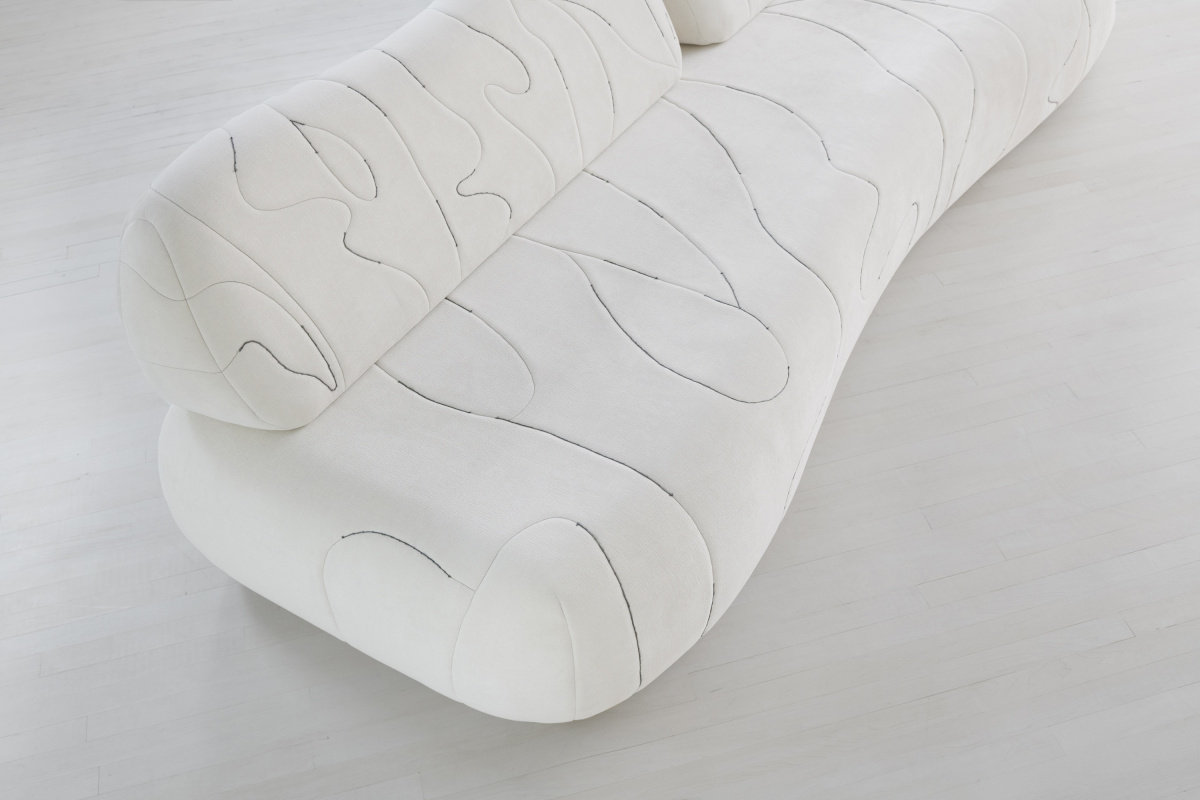
Wing and Landing Pad, featuring hand embroidery by Kelsey Falter, also produce tactile sound.
I was really drawn into the embroidery in Wing and Landing Pad.
We wanted to emulate oscillation and the frequencies that are being emitted in the space through those pieces, as well as through the caterpillar. Kelsey actually hand-stitched all of that herself. We’d like to produce more pieces that would have hand embroidery, but it will never be exactly the same.
I love that you engage all senses. In past exhibits, you’ve utilized olfactory to engage smell. Why, instead of just designing objects, have you targeted all senses?
We all express things completely differently. There are different strengths in our senses—you see something slightly different than how I see it. I may hear differently, and so on. So I think in a lot of these experiences that I’ve created, it’s like the more I engage different senses, the more someone else can pick up on something different. They’re going to have their own experience.
Do you see any divide between working in furniture versus working in fine art?
I guess the current pieces do kind of fall into the fine art world because they’re unique works. Caterpillar has nearly eighty panels, and each one takes so many hours to make. This particular product, though, is something that can be in many homes. I’m interested in creating fantastical, whimsical, pieces that are perspective pieces.
I think that simple design is actually really much harder for me. It’s still got to be unique to some degree, but sustainably created. I’m trying to shift focus and create something that is still an art object that may show in a gallery but also fits in a home or a hotel.
- The Throne incense burner, made from marble, ritualizes sensory experiences.
- The Pinnacle floor vase, made from marble, holds a single stem.
How has it been working with sound?
Honestly, it’s been a really fun process because it’s just doing something different. I get hired to make crazy, wild things, all the time, and that’s incredible that that’s my job. I think in this particular sense, the science behind it really excites me. In 2015, I made the Little House, which was a mirrored house. It was all about home being a reflection of where you are, but to actually find the home, you had to go on a journey. You couldn’t go through the front door, you had to crawl through a tunnel. When you got inside, you sat in this kaleidoscopic room with mirrors, and there were eight people doing binaural sound therapy. Binaural sound waves were the first thing that taught me how to meditate. There’s been an ongoing theme of sound being able to achieve altered states.
This latest body of work does that in a way that can be used by just about anyone for five to ten minutes a day. You receive a profound response on your nervous system.
Do you see the future of furniture design going into this immersive, sensory realm?
I do believe so. I think that technology is going to be in all of our things. This is just one type of tech that we’re going to be seeing. This is the future of home entertainment. People will use these specific soundscapes that we’ve created to create moods and journeys.
It sounds like you’re interested in wellness culture as a form of entertainment.
Most people coin this as wellness. I don’t call it wellness on purpose. I don’t want to tell people they’re going into a healing space. But they reach that space through the sounds of the experience. A lot of people say, I felt healed, or they felt like they had a borderline spiritual experience, or they’ll just go silent. Their eyes will close and they just smile.
- The Apex chime, designed by Kesley Falter for Raise the Moral, is a candle holder with a meditative twist.
- In BECOMING FAMILIAR, a botanical installation and bespoke embroidered mirror helped viewers reconnect with nature and self-reflection.
What other pieces in the collection stand out?
The Apex candle is a really interesting piece to look at. It’s basically a chime or an analog timer. You set the pin in the wax, like at like 15 minutes, 30 minutes, whatever it is, and then when that pin falls, it dings. This is a really special piece that I feel like it was a little bit overlooked.
Something else that stood out in your work are the backgammon boards. How did you become a backgammon artist?
Backgammon is one of my favorite games, and I always wanted to make a backgammon board, and then I got a commission. It has pearl and abalone, and It was a birthday present for someone. I became obsessed with inlay. I’m hoping to make more backgammon boards soon.
